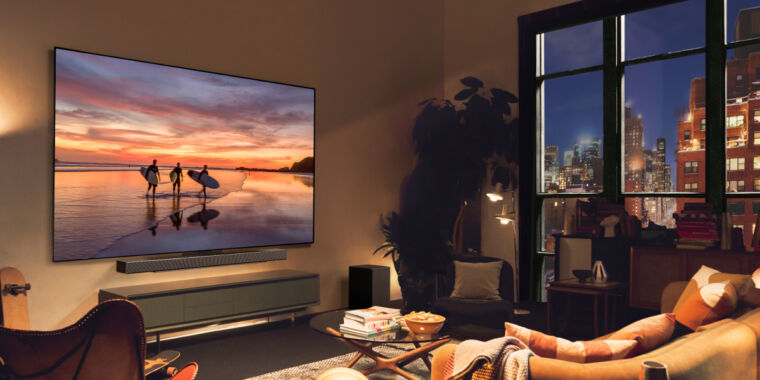The move embodies how ads are a growing and virtually inescapable part of the TV-viewing experience—even when you’re not watching anything.
As you might have expected, LG didn’t make a big, splashy announcement to consumers or LG TV owners about this new ad format. Instead, and ostensibly strategically, the September 5 announcement was made to advertisers. LG appears to know that screensaver ads aren’t a feature that excites users. Still, it and many other TV makers are happy to shove ads into the software of already-purchased devices.
LG TV owners may have already spotted the ads or learned about them via FlatpanelsHD, which today reported seeing a full-screen ad on the screensaver for LG’s latest flagship TV, the G4. “The ad appeared before the conventional screensaver kicks in," per the website, “and was localized to the region the TV was set to.”
LG has put these ads on by default, according to FlatpanelsHD, but you can disable them in the TVs’ settings. Still, the introduction of ads during a screensaver, shown during a pause in TV viewing that some TVs use as an opportunity to show art or personal photos that amplify the space, illustrates the high priority that ad dollars and tracking have among today’s TVs—even new top-of-the-line ones.
The addition of screensaver ads that users can disable may sound like a comparatively smaller disruption as far as TV operating system (OS) ads go. But the incorporation of new ad formats into TV OSes’ various nooks and crannies is a slippery slope. Some TV brands are even centered more on ads than selling hardware. Unfortunately, it’s up to OS operators and TV OEMs to decide where the line is, including for already-purchased TVs. User and advertiser interests don’t always align, making TV streaming platforms without third-party ads, such as Apple TV, increasingly scarce gems.



Not only do I use pi-hole, my so called smart TV never connects to the Internet in my household. Hell, I don’t buy any smart devices period.
I don’t use pi-hole currently, but have managed access via my router. My LG C1 has been locked down to LAN access only for a long time.
It’s kinds great this way. Since it has an IP it doesn’t give me any bullshit about network, but no traffic escapes the home network.
“Smart devices” are for stupid people.
“Smart” devices are getting increasingly difficult to avoid in many products categories.
Try buying a non-smart TV without going to high cost commercial/industrial models.
Don’t connect the wifi and use an external device. Have no issues with my now lobotomized screen.
Until they start to force you to connect to “finish” setup. I’m sure it’s only a matter of time.
For now my new LG turns on directly to my external device and isn’t connected to the Internet. I did have to change a setting to turn on to the last input used instead of the useless home screen.
Sure, as long as the device doesn’t automatically connect to open networks, and if it does, you don’t live in an apartment, or moderate density area with available open wi-fi networks in range.
consumer TVs are so ridiculously cheap precisely because of all the smart phone home nonsense
Depends on the device and the usage. “Smart devices” can encompass a lot of things.
A “smart device” is something that doesn’t need a pc in it AT ALL.
https://c.tenor.com/fbXP86oWtvAAAAAC/tenor.gif
edit: how tf embed gifs on lemmy
Or just use the sensibly placed identical lamp that’s next to his wife.
The only reason that lamp is positioned there is to sell that product.
deleted by creator
Format like this
So
thank you! saved